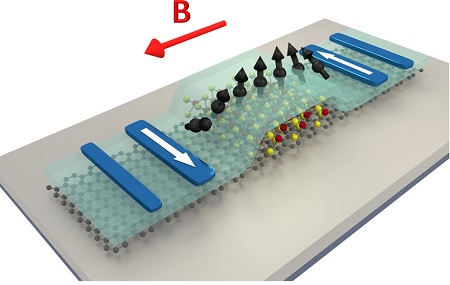Controlling Spin Direction in Sandwiches of Two-dimensional Materials
Apart from their charge, electrons also have a property called ‘spin’, which can be used to transport information. Graphene is an excellent conductor of electron spin, but it is very difficult to manipulate spins in this carbon-based material. University of Groningen scientists have now shown that molybdenum diselenide can be used to do just that. Their results were published in the journal Nano Letters.
Spin is a quantum dynamic property of electrons. Simply put, it makes electrons behave like small compass needles which can point up or down. In principle, this can be used to transfer or store information in what are known as spintronic devices. But there are many technical hurdles before spintronics can fulfil its potential.

The interaction of the spinning electrons with heavy atomic nuclei dissipates spin currents by a process called spin-orbit coupling. In graphene, a two-dimensional carbon material, spin-orbit coupling is very weak, making it an ideal conductor of spin currents. The drawback is that manipulating spins in graphene is very difficult.
Stacked
By contrast, the heavy atoms in molybdenum diselenide (MoSe2) produce strong spin-orbit coupling. And like graphite, this material has a layered crystal structure. Layers of MoSe2 and graphene can be stacked on top of each other. ‘We looked at whether we could use this technique to induce spin-orbit coupling in graphene’, says Talieh Ghiasi, PhD student in the Physics of Nanodevices group of Professor Bart van Wees.
The device they designed looks deceptively simple: a layer of graphene with a strip of MoSe2 on top, and covered by a double layer of boron nitride. The latter is used to prevent injected spins from returning to the electrode, and, as previous work from the same group has shown, to increase the spin signal. The team then placed ferromagnetic electrodes on both sides of the MoSe2 strip to measure spin currents through the graphene layer.

Ghiasi observed that the MoSe2 strip reduced the spin currents. But where previous attempts to affect spin currents have relied on draining spins from the graphene, this new experiment used a different mechanism. ‘The direction of spins in the graphene can be in-plane or out-of-plane. We used a magnetic field to differentiate between the two, and found that the MoSe2 reduced the current of in-plane spins only.’ The results showed a dramatic modulation: the spin signal drops from 30 Ohm to 15 mOhm, basically shutting down the in-plane spin current.
This anisotropic effect on spin is a known effect of MoSe2, but this time it was observed in a spin current in graphene. ‘This proves that in our device, the physics we know from MoSe2 is imprinted onto the graphene’, explains Ghiasi. ‘This is quite an exciting finding.’ The imprinting was predicted by theoretical models, but had so far never been observed in experiments.
Graphene Flagship
Bart van Wees, who leads the spintronics work package in the EUR 1 billion Graphene Flagship initiated by the European Union in 2013, explains the importance of this finding: ‘We have now found a totally new way of manipulating spins in graphene, which does not drain the spins from the material.’ This would make it possible to switch spin currents in graphene on and off, for example by using an electric field to tune the band-gap in MoSe2, which determines its effect on the spins. This will bring spin-based electronics one step closer.
Reference: Talieh S. Ghiasi, Josep Ingla-Aynés, A. Kaverzin, and Bart J. van Wees: Large Proximity-Induced Spin Lifetime Anisotropy in Transition Metal Dichalcogenide/Graphene Heterostructures. Nano Letters, DOI: 10.1021/acs.nanolett.7b03460 • Publication Date (Web): 27 Nov 2017
See also:
That’s cool: spin transport in an insulator
Groningen researchers steer spin transport
Groningen lab beats own world record
Spinoza prize winner Bart van Wees: Innovative, smaller and better
European Flagship with Groningen helmsman
| Last modified: | 11 February 2025 2.54 p.m. |
More news
-
01 April 2025
NSC’s electoral reform plan may have unwanted consequences
The new voting system, proposed by minister Uitermark, could jeopardize the fundamental principle of proportional representation, says Davide Grossi, Professor of Collective Decision Making and Computation at the University of Groningen
-
01 April 2025
‘AiNed’ National Growth Fund grant for speeding adoption of AI at SMEs
Professor Ming Cao receives an ‘AiNed’ Growth Fund grant of EUR 2.4 million for research that will contribute to faster adoption of AI at SMEs in the technical industry in the Netherlands.
-
01 April 2025
'Diversity leads to better science'
In addition to her biological research on ageing, Hannah Dugdale also studies disparities relating to diversity in science. Thanks to the latter, she is one of the two 2024 laureates of the Athena Award, an NWO prize for successful and inspiring...
